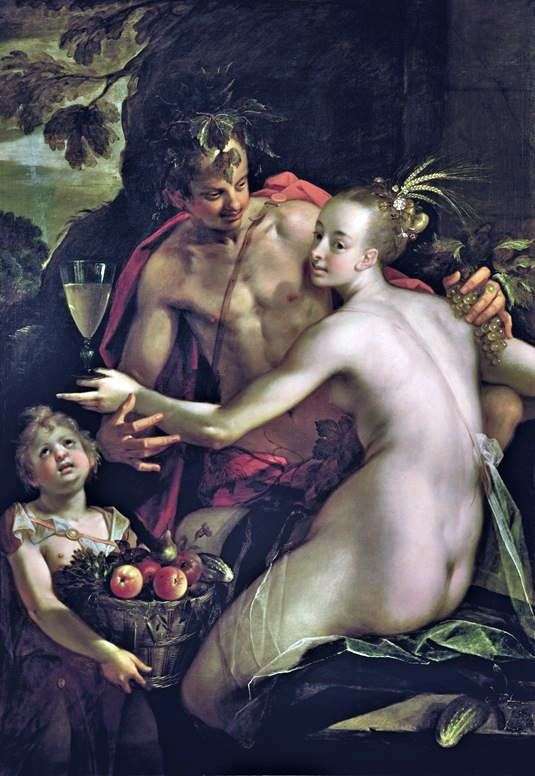
A painting by the German artist Hans von Aachen “Bacchus, Ceres and Cupid.” The size of the painting is 163 x 113 cm, canvas, oil. In the painting of a painter, a naked female body is uniquely represented as an object of sensual desire. The painting has a strong erotic energy, the artist was able to achieve that the flirtatious look of the goddess of fertility Ceres unambiguously addressed to the viewer. In Rome, the cult of Bacchus was borrowed from the South Italian Greeks, along with the cult of Demeter and Persephone.
In 496 BC a common temple was built for all three deities and an annual holiday was established in March – Liberia. Only much later was introduced the Greek mystical service to Bacchus, which here soon assumed the character of extreme debauchery and immorality.
Works of art earlier represent Bacchus in the form of a man already in adulthood, a majestic posture, with long hair and a beard, in long clothes, with a bandage on his head and a bowl or a brush of grapes in his hand. Later art portrayed Bacchus young men, a soft, delicate physique, completely naked or covered with a deer skin and in hunting cortex.
On his head he has a bandage and a wreath, in his hand there is a tiers. Ceres, in Roman mythology, the goddess of fertility; belongs to the most ancient gods of Rome. Its main function is the protection of sowing at all times of its development; therefore the oldest cult is closely associated with the cult of the even more ancient goddess Tellus.
 Bacchus, Cérès et Cupidon – Hans von Aachen
Bacchus, Cérès et Cupidon – Hans von Aachen Abduction of Proserpine by Hans von Aachen
Abduction of Proserpine by Hans von Aachen Prankster Bacchus by Guido Reni
Prankster Bacchus by Guido Reni Bacchus and Silen by Hans von Aachen
Bacchus and Silen by Hans von Aachen The amazement of the gods by Hans von Aachen
The amazement of the gods by Hans von Aachen Jupiter and Antioop by Hans von Aachen
Jupiter and Antioop by Hans von Aachen Vénus, Cupidon, Bacchus et Cérès – Peter Rubens
Vénus, Cupidon, Bacchus et Cérès – Peter Rubens Bahus, Ceres y Cupido – Hans von Aachen
Bahus, Ceres y Cupido – Hans von Aachen